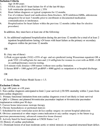High early event rates in patients with questionable eligibility for advanced heart failure therapies: Results from the Medical Arm of Mechanically Assisted Circulatory Support (Medamacs) Registry
- PMID: 26987599
- PMCID: PMC4917444
- DOI: 10.1016/j.healun.2016.01.014
High early event rates in patients with questionable eligibility for advanced heart failure therapies: Results from the Medical Arm of Mechanically Assisted Circulatory Support (Medamacs) Registry
Abstract
Background: The prognosis of ambulatory patients with advanced heart failure (HF) who are not yet inotrope dependent and implications for evaluation and timing for transplant or destination therapy with a left ventricular assist device (DT-LVAD) are unknown. We hypothesized that the characteristics defining eligibility for advanced HF therapies would be a primary determinant of outcomes in these patients.
Methods: Ambulatory patients with advanced HF (New York Heart Association class III-IV, Interagency Registry for Mechanically Assisted Circulatory Support profiles 4-7) were enrolled across 11 centers from May 2013 to February 2015. Patients were stratified into 3 groups: likely transplant eligible, DT-LVAD eligible, and ineligible for both transplant and DT-LVAD. Clinical characteristics were collected, and patients were prospectively followed for death, transplant, and left ventricular assist device implantation.
Results: The study enrolled 144 patients with a mean follow-up of 10 ± 6 months. Patients in the ineligible cohort (n = 43) had worse congestion, renal function, and anemia compared with transplant (n = 51) and DT-LVAD (n = 50) eligible patients. Ineligible patients had higher mortality (23.3% vs 8.0% in DT-LVAD group and 5.9% in transplant group, p = 0.02). The differences in mortality were related to lower rates of transplantation (11.8% in transplant group vs 2.0% in DT-LVAD group and 0% in ineligible group, p = 0.02) and left ventricular assist device implantation (15.7% in transplant group vs 2.0% in DT-LVAD group and 0% in ineligible group, p < 0.01).
Conclusions: Ambulatory patients with advanced HF who were deemed ineligible for transplant and DT-LVAD had markers of greater HF severity and a higher rate of mortality compared with patients eligible for transplant or DT-LVAD. The high early event rate in this group emphasizes the need for timely evaluation and decision making regarding lifesaving therapies.
Keywords: cardiac transplantation; destination therapy; mechanical support; patient selection; ventricular assist device.
Copyright © 2016 International Society for Heart and Lung Transplantation. Published by Elsevier Inc. All rights reserved.
Conflict of interest statement
The remaining authors have no disclosures.
Figures



References
-
- Lund LH, Edwards LB, Kucheryavaya AY, et al. The registry of the International Society for Heart and Lung Transplantation: thirty-first official adult heart transplant report--2014; focus theme: retransplantation. J Heart Lung Transplant. 2014;33:996–1008. - PubMed
-
- Kirklin JK, Naftel DC, Pagani FD, et al. Sixth INTERMACS annual report: a 10,000-patient database. J Heart Lung Transplant. 2014;33:555–564. - PubMed
-
- Gorodeski EZ, Chu EC, Chow CH, Levy WC, Hsich E, Starling RC. Application of the Seattle Heart Failure Model in ambulatory patients presented to an advanced heart failure therapeutics committee. Circ Heart Fail. 2010;3:706–714. - PubMed
-
- Sartipy U, Goda A, Yuzefpolskaya M, Mancini DM, Lund LH. Utility of the Seattle Heart Failure Model in patients with cardiac resynchronization therapy and implantable cardioverter defibrillator referred for heart transplantation. Am Heart J. 2014;168:325–331. - PubMed
MeSH terms
Grants and funding
LinkOut - more resources
Full Text Sources
Other Literature Sources
Medical
Research Materials
Miscellaneous

